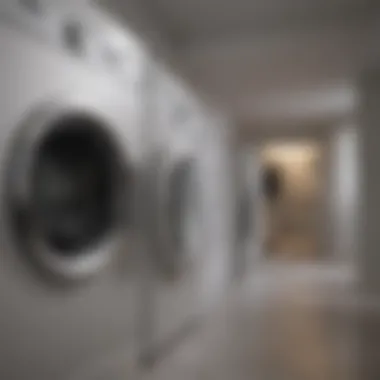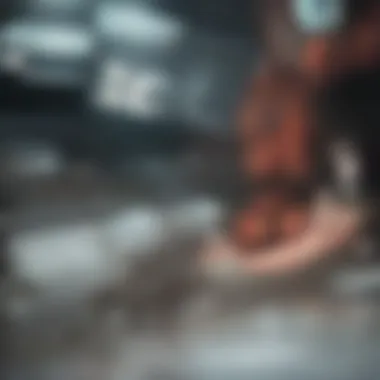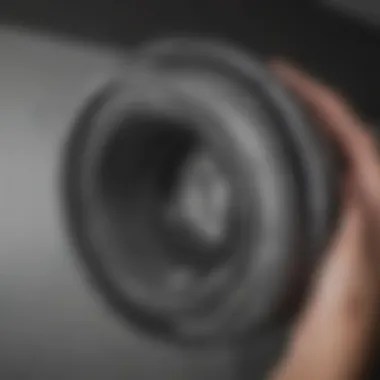Essential Guide to Cleaning Dryer Ducts Effectively


Intro
Cleaning dryer ducts from inside your home is a task often overlooked but essential for maintaining safety and efficiency. Over time, lint and debris accumulate, blocking airflow and posing potential fire hazards. Knowing how to clean your ducts properly can empower homeowners to take control of their appliance maintenance and improve its functionality.
In this guide, we will delve deeply into the cleaning process, discuss necessary tools, and highlight the importance of regular maintenance. A structured approach ensures that even those new to home upkeep can confidently navigate this task.
Importance of Cleaning Dryer Ducts
Dryer ducts play a crucial role in the operation of your dryer. They carry moisture and lint out of the machine, ensuring optimal performance and drying efficiency. A clogged duct can lead to several issues:
- Decreased Efficiency: A blocked duct means longer drying times, leading to increased energy consumption.
- Fire Hazard: Lint is highly flammable. When dryer ducts become clogged, the risk of a fire increases significantly.
- Damage to the Appliance: Restricted airflow can strain the dryer, possibly leading to costly repairs or even needing a replacement.
Taking the steps to keep your ducts clean can protect your home and promote a safer drying process.
Tools and Materials for Cleaning
To tackle the cleaning process thoroughly, you will need specific tools. Here's a list of what you will find useful:
- Vacuum Cleaner with Hose Attachment: A high-powered vacuum will help remove lint effectively.
- Dryer Vent Cleaning Brush: This specialized brush can reach deep into ductwork for a thorough clean.
- Flexible Rods: These can help extend your reach inside the ducts.
- Safety Goggles and Gloves: Protect yourself from debris and sharp edges.
Having the right tools makes the cleaning process smoother, ensuring a more thorough job.
Step-By-Step Cleaning Process
The following steps outline how to clean your dryer ducts from inside your home effectively:
- Disconnect the Dryer: Safety must come first. Unplug your dryer from the power source to prevent accidents.
- Access the Duct: Remove any connectors or screws to access the duct.
- Inspect the System: Check for any visible lint buildup or blockages using a flashlight.
- Insert the Cleaning Brush: Gently push the brush into the duct, rotating it to dislodge lint and debris.
- Clean with Vacuum: Use the vacuum to collect loosened debris. Make sure to go through both the duct and the area behind the dryer.
- Reassemble Everything: Once you’re certain it is clean, reattach the duct, plug in the dryer, and ensure it runs smoothly.
Regular cleaning of dryer ducts is essential for home safety. Schedule this task at least once a year to ensure optimal performance.
Common Challenges
Cleaning dryer ducts can present challenges:
- Limited Space: Some duct systems have tight turns and may be difficult to navigate.
- Long Duct Runs: If ducts extend far from the dryer, cleaning them can be cumbersome.
- Obstructions: Old ductwork may have obstructions that are hard to access without professional help.
Identifying these challenges beforehand allows for better preparation. If needed, do not hesitate to seek professional assistance.
Preventative Measures
Keeping your dryer ducts clean is not a one-time task. Consider these preventative steps:
- Use a Lint Trap: Always clean the lint trap after each cycle.
- Limit Loads: Avoid overloading your dryer to reduce lint buildup.
- Check Duct for Damage: Periodically inspect ducts for signs of wear or damage.
Incorporating these practices can enhance not just safety but also the overall longevity of your dryer.
Finale
Cleaning dryer ducts is crucial for both safety and efficiency. With the right tools and knowledge, homeowners can effectively maintain their duct systems. Regular inspections and preventative measures contribute to a cleaner, safer home environment. Embrace the empowerment that comes with understanding and improving your home systems.
Preamble to Dryer Duct Cleaning
Cleaning dryer ducts is a crucial aspect of home maintenance that often goes overlooked. Many homeowners do not realize the role that dryer ducts play in both safety and appliance efficiency. Over time, lint and debris accumulate in these ducts, creating a fire hazard and reducing the effectiveness of the dryer.
In some cases, neglected dryer ducts can lead to inefficient drying cycles, resulting in higher energy bills and increased wear on the appliance. This not only prolongs the drying time but can also ultimately reduce the lifespan of the dryer. Therefore, understanding how to properly clean and maintain dryer ducts is imperative for ensuring a safe and efficient home environment.
The upcoming sections will explore the steps and tools necessary for effective dryer duct cleaning. They will provide detailed guidance on how to maintain these ducts for optimal functioning. Additionally, the article will cover common challenges faced during duct cleaning and give practical solutions to overcome these issues. By focusing on both the practicality and the need for regular maintenance, this guide aims to empower homeowners to take action in protecting their households from potential hazards while enhancing appliance performance.
Understanding the Importance of Dryer Duct Maintenance
Maintaining dryer ducts is not just a recommended task; it is essential for safety and efficiency in every household. Clogged or poorly maintained dryer ducts can lead to a host of problems, ranging from fire hazards to increased energy costs. It is crucial to understand these aspects to appreciate why dryer duct maintenance should be a priority for homeowners.


One of the most significant risks associated with neglected dryer ducts is the increased likelihood of fire. According to the U.S. Fire Administration, lint buildup is a direct cause of thousands of residential fires every year. Dryers generate substantial heat during operation, and when ducts are clogged, heat cannot dissipate properly. This trapped heat can ignite lint and other combustible materials, resulting in catastrophic consequences. Regular cleaning of dryer ducts can mitigate this risk, ensuring that exhaust air flows freely and safely.
Furthermore, ignoring duct maintenance can lead to poor dryer efficiency. Build-up of lint and debris reduces airflow, placing excess stress on the dryer components. This inefficiency manifests in longer drying times and increased energy consumption. Homeowners may notice higher electricity bills and may eventually face costly repairs or the need to replace their dryer sooner than expected. Addressing these duct issues not only saves money in the long run but also prolongs the life of the dryer.
In addition to these critical benefits, it's important to consider the overall impact on air quality in the home. Clogged ducts can lead to mold and mildew growth, especially in humid environments. This can result in unpleasant odors and negative health impacts for those living in the space. Ensuring that dryer ducts are efficiently clean regularly contributes to better indoor air quality.
Overall, understanding the importance of dryer duct maintenance emphasizes the need for homeowners to proactively manage the cleanliness of their ducts. Engaging in regular cleaning practices assists in avoiding safety hazards, improving efficiency, and maintaining a healthy living environment.
"Preventative actions like regular dryer duct inspections and cleanings can save lives, reduce energy usage, and enhance home comfort."
In summary, being informed about the dangers and the potential costs associated with neglected dryer ducts makes a compelling case for routine maintenance. This awareness empowers homeowners to take action, ensuring their homes remain safe and efficient.
Tools and Materials Required for Cleaning
Cleaning dryer ducts effectively requires the right tools and materials. This section details the essential items needed for a thorough cleaning process. The right tools not only make the task easier but also ensure that the ducts are cleaned safely and efficiently, thus prolonging the lifespan of the dryer and maintaining indoor air quality. It is vital to select the appropriate materials to avoid damaging the ducts and to achieve better results.
Essential Cleaning Tools
When maintaining your dryer ducts, a few key tools can make a significant difference. Here are the main tools recommended for cleaning dryer ducts.
Vacuum Cleaner
The vacuum cleaner plays a crucial role in dryer duct cleaning. It helps in removing loose lint and debris that can accumulate in the ducts. A vacuum with a strong suction power is advisable for the best outcomes. Notably, some vacuum cleaners come with specialized attachments that enable better access to tight spaces within the duct system. While the convenience of a vacuum is clear, make sure it has the ability to reduce the risk of fire hazards linked with lint accumulation.
Brushes
Brushes are an indispensable tool when cleaning dryer ducts. They are designed specifically to sweep away stubborn lint and debris that a vacuum alone may miss. These brushes often have flexible handles, making it easier to navigate bends and turns within the ductwork. The bristles on these brushes are sturdy enough to dislodge stuck particles yet gentle enough to avoid damaging the duct walls. Incorporating brushes into your cleaning routine can enhance the thoroughness of the cleaning process.
Duct Cleaning Kits
Duct cleaning kits provide a comprehensive solution for homeowners tackling dryer duct cleaning. These kits typically include a variety of brushes, rods, and attachments, allowing for a more flexible approach to cleaning various duct configurations. A significant advantage of duct cleaning kits is that they often come with instructional guides, which can be very useful for those unfamiliar with the cleaning process. However, it is essential to choose a kit that fits the specific size and type of your dryer ducts for optimal results.
Safety Gear Recommendations
Ensuring personal safety while cleaning your dryer ducts is essential. Using safety gear minimizes the risks associated with dust and debris exposure during the cleaning process. Below are some recommended safety items that should be part of your cleaning preparations.
Gloves
Gloves protect your hands from dirt and debris during the cleaning process. When selecting gloves, consider types that provide a good grip while being durable enough to withstand the cleaning task. Leather or rubber gloves are often good options as they offer protection and sturdiness. Proper gloves also prevent skin irritation from allergens or rough surfaces often encountered during the cleaning process.
Dust Masks
Wearing dust masks is critical for safeguarding your respiratory system while cleaning dryer ducts. Dust from lint and debris can irritate lungs or trigger allergies. A quality dust mask filters out small particles, ensuring that you breathe clean air while you work. It is important to choose a mask that provides a snug fit to maximize its effectiveness during the cleaning tasks.
Safety Goggles
Safety goggles are essential for protecting your eyes from dust and debris that may become dislodged during the cleaning process. When working with brushes or cleaning tools, small particles can easily fly into your eyes. Goggles designed for this purpose are typically anti-fog and provide a clear line of sight while you work. Choosing goggles that create a tight seal around the eyes will offer the best protection and comfort.
Remember, safety first: always wear appropriate gear when cleaning dryer ducts to minimize health risks.
Preparing for the Cleaning Process
Before diving into the cleaning of your dryer ducts, it is essential to prepare adequately. This preparation step is critical for ensuring that the cleaning process is safe, efficient, and thorough. An organized approach reduces the risk of accidents and helps in resolving any challenges you may face during the cleaning.
Identifying the Dryer Duct System Configuration
Understanding the configuration of your dryer duct system is the first step in the preparation process. This involves determining the layout, including the length, bends, and connections of the ducts. Each installation may vary significantly, and knowing your system can provide insights into where clogs are most likely to occur. Take time to:
- Trace the path of the duct from the dryer to the exterior vent.
- Identify all obstacles and turns within the duct.
- Locate any accessible entry points for effective cleaning.
By knowing the configuration, you can anticipate areas that may require extra attention or special tools during the cleaning.


Shutting Off Power and Ventilation
Safety cannot be overstated in any home maintenance task. Before you start cleaning, take precautions to ensure you are not exposed to electrical hazards or potential injuries from moving parts. First, shut off power to the dryer. This can usually be done by unplugging it from the wall outlet or turning off the circuit breaker. After ensuring power is disconnected:
- Ensure that the dryer is completely offline.
- Check for any lingering heat in the dryer components.
- Disable ventilation systems in the area to prevent dust and debris from circulating.
These steps mitigate risks and help create a safer working environment. Ensuring that power and ventilation are off can prevent unintentional hazards during the cleaning process.
Safety Reminder: Always wear appropriate safety gear when handling cleaning materials, including gloves and masks to protect against dust and debris.
Step-by-Step Guide to Cleaning Dryer Ducts from the Inside
Cleaning dryer ducts from the inside is essential to ensure optimal performance and safety of your dryer. Over time, lint and debris accumulate in the ducts, leading to potential hazards such as fires and decreased dryer efficiency. This section walks you through the precise steps for effectively cleaning your dryer ducts, ensuring they operate smoothly.
Accessing the Duct System
Removing the Dryer
Before cleaning the ducts, the first step is to remove the dryer from its position. This step is vital, as it allows you full access to the duct entry point. Depending on your space configuration, removing the dryer can be a simple task. The key characteristic of this process is the ease with which you can access the duct system.
To do this, you typically need to disconnect the power supply and the vent hose. Be careful while moving the dryer as it can be heavy. A beneficial aspect of removing the dryer is that it offers a clear view of the duct system, enabling a thorough cleaning. However, it can be an arduous task for some, especially in tight spaces.
Locating the Duct Entry Point
Locating the duct entry point is another crucial step in this cleaning process. This entry point is where the appliance connects to the ductwork leading outside. Knowing its location is essential as it helps you direct your cleaning efforts actively.
The key characteristic of identifying the entry point is that it is often hiding behind the dryer. This can make it challenging to find for some homeowners. Nevertheless, it is a beneficial feature because once you locate it, you gain insight into the whole duct path. A unique advantage of pinpointing this entry is that it allows further assessments of potential blockages or damages.
Removing Debris with a Vacuum
Using a vacuum cleaner is a straightforward and effective method for removing lint and debris from the duct. A vacuum equipped with a long hose attachment will help you reach deep into the ductwork. Make sure to do this thoroughly to minimize future buildup. The simplicity of this method makes it popular among DIY homeowners.
Using a Brush for Thorough Cleaning
After vacuuming, using a brush can enhance your cleaning process. A duct cleaning brush is specially designed to brush away stubborn lint that the vacuum might miss. The action of scrubbing helps dislodge any remaining debris, facilitating a more comprehensive clean. This additional step significantly aids in preventing future issues for the dryer.
Inspecting for Damage or Obstructions
Once the ducts are cleaned, it is essential to inspect them for any damage or obstructions. Look for cracks, holes, or misaligned sections. Damages can restrict airflow and lead to future problems. This inspection is critical as it ensures that your dryer operates efficiently and safely.
Reassembling the Duct System
After you have cleaned and inspected the ducts, it’s time to reassemble the duct system. Ensure that all connections are secure and sealed properly. Any gaps may allow air to escape or lead to lint build-up once more. Proper reassembly ensures efficient airflow, which directly affects the performance of your dryer.
Restoring Power and Ventilation
The final step involves restoring the power supply to the dryer and connecting the ventilation system back. Make sure everything is functioning correctly after replacing it to its original position. Checking the connections at this stage is crucial for ensuring that there are no leaks or blockages after installation.
Remember, maintaining clean and functioning dryer ducts is vital for safety and efficiency.
Common Challenges in Cleaning Dryer Ducts
As homeowners take on the task of cleaning dryer ducts, they may encounter a few challenges along the way. Recognizing these difficulties is crucial for ensuring a smooth and effective cleaning process. Addressing issues like long or complex duct systems is important, as it may require specialized tools or techniques to reach hidden areas. Similarly, stubborn build-up from lint and debris can make cleaning less straightforward. Understanding these common challenges equips homeowners with the information they need to maintain safety and efficiency in their equipment.
Dealing with Long or Complex Ducts
When dryer ducts extend over a significant distance or have many bends and turns, cleaning them can become complicated. The airflow may become restricted due to the design, making it easier for lint to accumulate in hard-to-reach areas.
If you have a long or intricate duct system, consider the following:
- Use Flexible Duct Brushes: These brushes can navigate bends and curves effectively. Ensure you choose a size that fits your duct diameter.
- Duct Inspection Camera: Before cleaning, using a camera can help you see where build-up may be present. This tool can guide your cleaning process.
- Multiple Access Points: Create access points if possible, which will make your cleaning efforts more thorough.


Cleaning long ducts may take more time, but it is essential. Regular maintenance in these systems is critical to preventing fire hazards and maintaining dryer efficiency.
Removing Stubborn Build-Up
Some areas in a dryer duct may accumulate lint and debris to the point where it becomes very resistant to removal. Stubborn build-up requires an organized approach.
Here are steps to effectively tackle this issue:
- Ventilate the area: Ensure there is adequate airflow in your working area to reduce dust inhalation.
- Soak Brushes: If using brushes, soak them in warm water with soap to enhance their cleaning effectiveness.
- Scraping Tools: Gentle scraping tools might be necessary to dislodge heavy debris without damaging the ducts.
- High-Power Vacuum: Employ a high-suction vacuum specifically designed for cleaning ducts. This equipment can often remove residues in one go.
Underestimating the presence of stubborn build-up can lead to inefficient cleaning. It is vital to account for this when planning the cleaning process.
"A clean dryer duct is not just beneficial for the equipment; it is vital for household safety."
Preventative Measures for Maintaining Clean Dryer Ducts
Maintaining clean dryer ducts is not just about addressing the issue after it arises. Instead, adopting preventative measures can significantly enhance the safety and efficiency of your dryer system. By implementing a few proactive strategies, homeowners can minimize the risk of clogs, reduce the chance of a fire, and maintain optimal dryer performance over time.
Regular Inspections
Conducting regular inspections of your dryer ducts is fundamental in ensuring that they remain clear and functional. Homeowners should visually check vents, ducts, and connections at least once every few months. Look for signs of lint accumulation or any obstructions that may hinder airflow.
Additionally, inspecting your dryer’s vent hose for damage or kinks is essential. A compromised hose can lead to a buildup of lint and provide a perfect environment for fires. If you notice any signs of wear or holes, replacing the duct might be necessary.
- How to Perform an Inspection:
- Start by turning off the dryer and unplugging it for safety.
- Remove the vent from the back of the dryer carefully.
- Use a flashlight to inspect inside the duct and the vent cap on the exterior of your home.
Timely inspections allow you to catch problems early, making the process of cleaning and maintenance much simpler.
Establishing a Cleaning Schedule
A regular cleaning schedule is a proactive strategy that any homeowner should adopt. This schedule will serve as a reminder to clean your dryer ducts before they become clogged or problematic. Depending on usage, cleaning should typically be done every six months to a year. For families that do frequent laundry loads, consider cleaning every few months.
Keeping a calendar or setting reminders on your phone can aid in this effort.
- What to Include in Your Schedule:
- Dates for visual inspections and deep cleaning.
- Notes on any repairs or replacements of duct components.
- A checklist of tools needed for cleaning each time.
Regularly scheduled maintenance can prevent the buildup of lint and other debris, ensuring that your dryer operates efficiently.
Installing a Lint Trap Filter
Installing a lint trap filter is another effective measure to maintain cleaner dryer ducts. While most dryers come with their built-in lint filters, additional filters can be added at various points along the ductwork. These filters help capture lint before it can enter and clog deeper sections of the duct.
- Benefits of Lint Trap Filters:
- Reduces the frequency of duct cleaning needed.
- Lowers the risk of fires caused by lint accumulation.
- Improves the overall efficiency of the dryer, leading to shorter drying times and energy savings.
It is essential to clean the lint trap filter regularly to ensure it does not become an obstruction itself.
Keeping your dryer ducts well-maintained through preventative measures is crucial for safety, efficiency, and longevity.
By incorporating these preventative strategies into your home maintenance routine, you will enable a more effective cleaning process and a safer home environment. Dryer maintenance is not an afterthought; rather, it is an essential part of responsible home care.
The End
In this comprehensive guide, the importance of maintaining clean dryer ducts from inside your home cannot be overstated. Regular cleaning significantly impacts both safety and efficiency, allowing homeowners to reduce the risk of fire hazards and improve drying performance.
One of the most pressing considerations is the accumulation of lint and debris within the duct system. Failing to address this accumulation not only heightens the risk of fires but can also lead to overheating and potential damage to the dryer itself. By ensuring that ducts are cleaned regularly, you can prevent these serious safety issues.
Moreover, a clean duct system enhances dryer efficiency. An obstructed duct forces the dryer to work harder, which increases energy consumption and prolongs drying times. Repeatedly dealing with damp clothes can lead to frustration and wasted time. Regular maintenance helps maintain optimal airflow, which in turn extends the life of your appliance.
Additionally, implementing a routine inspection and cleaning schedule should be a priority. This systematic approach ensures that problems are identified early, thus saving time and potentially costly repairs. As part of a broader preventative strategy, such measures will keep your home in good condition and ensure your dryer operates effectively.
"Home maintenance is not just about repair; it is about prevention and care, ensuring your space is safe and functional."
Ultimately, consistent attention to dryer duct cleanliness reflects a proactive approach to home care that benefits not just the individual homeowner but also contributes to the broader safety and efficiency standards within communities.















